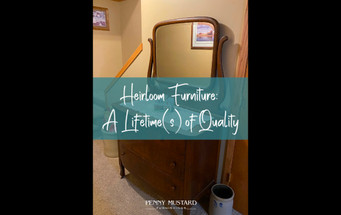Heirloom Furniture: A Lifetime(s) of Quality
Feb 20th 2021
It’s easy to forget that many of the precious family heirlooms we hold dear were simple household items that our relatives used every day. Quality craftsmanship is the key to ensure your future family treasures will stand the test of time. In fact, you may leave a legacy for your loved ones with something as simple as a well-built bedroom dresser. That’s what happened to the Huth family.
ARVID: “We have a story of – Ben can tell a story a little bit better – a story on a couple of pieces of furniture in our history that were really neat.”
BEN: “Well, when our parents were moving from the farm to town – when they retired – all these old pieces had to go somewhere because they were getting a smaller place. And so we each got some furniture and there was one piece that still had our grandmother’s name on it. It was the delivery ticket basically. It was on the back of the piece and it had our grandmother’s name.”
ARVID: “Written with a lead pencil – but a big, fat lead pencil – because it was almost as big as a magic marker.”
BEN: “On this piece of paper. And instead of an address, it just said Boyd, Wisconsin. Like her name, Boyd, Wisconsin, that was the delivery address.”
ARVID: “Back then, that’s all you needed for an address.”
BEN: “Right. You get the Boyd, you asked this name, they tell you right where to go apparently.”
ARVID: “That was a piece of furniture all five of us kids wanted.”
BEN: “Yeah.”
ARVID: “You know, of all the furniture that had her name on it. “
BEN: “Right.”
ARVID: “It had grandma’s name on it.”
BEN: “And the rest of the pieces, you know, you have the story of whose piece this was and whose piece that was. But you don’t have the exact details of it. You know?”
And even today I tell people, you know, I tell people that – people that asked me like, ‘Okay, I bought this piece of heirloom furniture. Is there anything special I should do with it?’ You know?
And I know they’re asking, like, ‘How do I take care of it? What do I do with the finish?’
You know, what’d you do with it?
Flip it over. Turn it around. Take a magic marker and write on that thing.
Your name. When you bought this. Where you bought it from. Why you bought it.
That piece will be cherished in your family for centuries to come.”
ARVID: “People want to be connected to their ancestors a little bit and this is one way of doing that. And, you know, if you can touch something that your grandmother or great-grandmother or maybe your great, great, great, great, great grandmother touched – that’s beautiful.”
BEN: “Yeah. That’s really, really neat. And the furniture we’re building today are those pieces. Those pieces that are going to be here, you don’t have to be embarrassed about them. They’re pieces that 300 years from now somebody’s going to be like, ‘Wow, that thing was well built for its time.”












